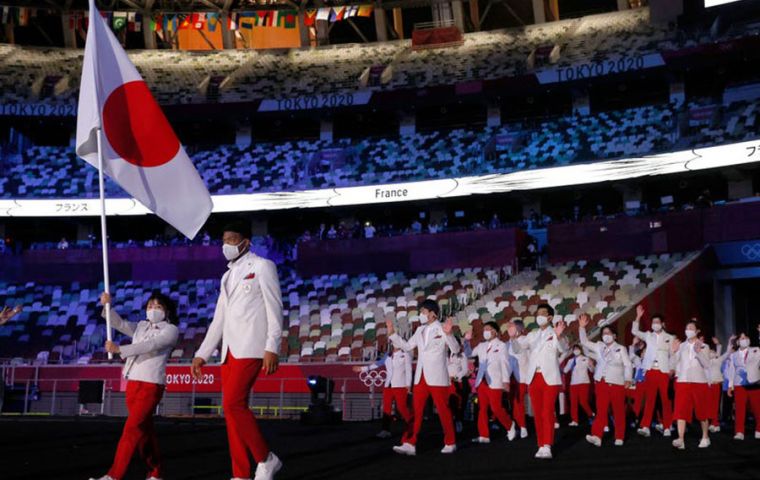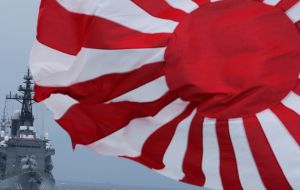MercoPress. South Atlantic News Agency
Japanese rising sun flag controversy in Tokyo Olympic Games
 Japan actually has two rising sun flags, one of them is the national emblem, “nisshoki” or “hinomaru” which means the origin of the sun (red circle on a white background)
Japan actually has two rising sun flags, one of them is the national emblem, “nisshoki” or “hinomaru” which means the origin of the sun (red circle on a white background)  The other has the red circle with 16 expanding beams, it is identified as “kyokujitsuki”, and has many Japanese neighbors tormented since it was standard imperial navy when the invasions
The other has the red circle with 16 expanding beams, it is identified as “kyokujitsuki”, and has many Japanese neighbors tormented since it was standard imperial navy when the invasions The rising sun flag is dear to the Japanese and part of its history. However, for the two Koreas, China, Myanmar, Malaysia, and other Asian nations, it is a symbol of the war atrocities committed by Japanese forces in the past. That is why flying the flag at the Tokyo Olympics has caused an uproar demanding it is banned from the Games.
Japan actually has two rising sun flags, one of them is the national emblem, “nisshoki” or “hinomaru” which means the origin of the sun (red circle on a white background) and which causes few reactions. But the other has the red circle with 16 expanding beams, it is identified as “kyokujitsuki”, and has many Japanese neighbors tormented.
However the flag with the sun and beams became the symbol of the imperial navy particularly when they invaded and occupied the Korean peninsula, and later went on to occupy other areas of China. Naval self defense forces of Japan still use this flag and since 1954 land forces have a slightly different one. Japanese ultra nationalists love the sun and beams flag.
The Japanese government argues that both flags have been flown by the country well before any international conflicts and even fishermen when have a good catch like to fly the flag with the sun and beams.
Current Prime Minister Yoshhide Suga, back in 2013 as cabinet minister explained that “arguing such a flag is a political declaration or a symbol of militarism is irrelevant, I think it is a great misunderstanding”. But in 2019, South Korea formally requested the International Olympic Committee to ban the flag with the sun and beams during the 2020 Games in Tokyo.
Seoul said the flag reminds the pain and suffering of the country during the military aggression at the beginning of last century until 1945, while North Korea describes it as a flag of “war criminals” and an “intolerable insult to our people and others in Asia”.
China had for years a similar attitude but with time it has changed to political, economic and cultural rivalry towards Japan, together with the US and EU.
The situation with South Korea has worsened because apparently there was an agreement that the “offensive” flag would not be flown in the Olympic stadiums, but this did not happen while Korean athletes were forced to take out some provocative banners they hanged from their rooms in the Olympic village.
South Korean president Moon Jae-in announced he will not be attending the Tokyo Games as a special guest since the two sides have been unable to consolidate sufficient space to hold a leaders' summit. Likewise both Korea and China have been demanding a “sincere apology” from Japan for the atrocities during the war, but Tokyo has always fallen short of going that far.
Anyhow the flags dispute will be limited since these are the first Olympics with no spectators because of the pandemic and so there will be no flying of colors and possible incidents.

![“Working directly with President [Donald] Trump and Congress, we accomplished what no one else could,” Patel stressed](/data/cache/noticias/108417/130x80/fbi.jpg)


Top Comments
Disclaimer & comment rulesCommenting for this story is now closed.
If you have a Facebook account, become a fan and comment on our Facebook Page!